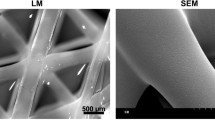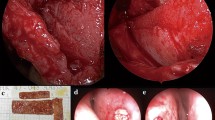Abstract
Purpose
To investigate the long-term safety and efficacy of a 3D-printed bioresorbable polycaprolactone (PCL) nasal implant for nasal septal deformity reconstruction.
Methods
Fourteen patients who had undergone nasal septum reconstruction surgery using 3D-printed PCL nasal septal implants were enrolled. The primary outcome was the change in total Nasal Obstruction Symptom Evaluation (NOSE) scale scores between postoperative 3 months and current status (3.59 ± 0.51 years). The secondary outcomes were changes in the minimum cross-sectional area (MCA) and volume of both nasal cavities based on acoustic rhinometry, the cross-sectional area of the ostiomeatal unit, and the nasal septum angle of the paranasal sinus (PNS) in computed tomography (CT) images, and a visual analog scale (VAS) of the patients’ subjective satisfaction.
Results
The results showed no significant changes in the MCAs (Cohen’s d:0.09; p = 0.711) or nasal volume (Cohen’s d:0.26; p = 0.356), the area of the ostiomeatal unit (Cohen’s d:0.49; p = 0.064), septum angles (Cohen’s d:0.18; p = 0.831), the NOSE scale (Cohen’s d:0.14; p = 0.621), or patients’ subjective satisfaction (Cohen’s d:0.52; p = 0.076) during the follow-up period.
Conclusions
This homogeneous composite microporous PCL nasal septal implant demonstrated long-term clinical efficacy and safety in human tissues that required maintenance of mechanical strength. Therefore, the indications for this implant could extend to various other craniofacial reconstructions in the future.



Similar content being viewed by others
Data availability
All data files are available from the figureshare database without limitations. (https://doi.org/10.6084/m9.figshare.13646507.v1).
References
Fan D, Li Y, Wang X, Zhu T, Wang Q, Cai H, Li W, Tian Y, Liu Z (2020) Progressive 3D printing technology and its application in medical materials. Front Pharmacol 11:122. https://doi.org/10.3389/fphar.2020.00122
Teoh SH, Goh BT, Lim J (2019) Three-dimensional printed polycaprolactone scaffolds for bone regeneration success and future perspective. Tissue Eng Part A 25:931–935. https://doi.org/10.1089/ten.TEA.2019.0102
Grayson WL, Fröhlich M, Yeager K, Bhumiratana S, Chan ME, Cannizzaro C, Wan LQ, Liu XS, Guo XE, Vunjak-Novakovic G (2010) Engineering anatomically shaped human bone grafts. Proc Natl Acad Sci U S A 107:3299–3304. https://doi.org/10.1073/pnas.0905439106
Lee JS, Lee DC, Ha DH, Kim SW, Cho DW (2016) Redefining the septal L-strut to prevent collapse. PLoS ONE 11:e0153056. https://doi.org/10.1371/journal.pone.0153056
Li Z, Tan BH (2014) Towards the development of polycaprolactone based amphiphilic block copolymers: molecular design, self-assembly and biomedical applications. Mater Sci Eng C Mater Biol Appl 45:620–634. https://doi.org/10.1016/j.msec.2014.06.003
Hutmacher DW, Goh JC, Teoh SH (2001) An introduction to biodegradable materials for tissue engineering applications. Ann Acad Med Singapore 30:183–191
Antheunis H, van der Meer JC, de Geus M, Heise A, Koning CE (2010) Autocatalytic equation describing the change in molecular weight during hydrolytic degradation of aliphatic polyesters. Biomacromol 11:1118–1124. https://doi.org/10.1021/bm100125b
Sun H, Mei L, Song C, Cui X, Wang P (2006) The in vivo degradation, absorption and excretion of PCL-based implant. Biomaterials 27:1735–1740. https://doi.org/10.1016/j.biomaterials.2005.09.019
Peña J, Corrales T, Izquierdo-Barba I, Doadrio AL, Vallet-Regí M (2006) Long term degradation of poly(ɛ-caprolactone) films in biologically related fluids. Polym Degrad Stab 91:1424–1432. https://doi.org/10.1016/j.polymdegradstab.2005.10.016
Kim DH, Yun WS, Shim JH, Park KH, Choi D, Park MI, Hwang SH, Kim SW (2018) Clinical application of 3-dimensional printing technology for patients with nasal septal deformities: a multicenter study. JAMA Otolaryngol Head Neck Surg 144:1145–1152. https://doi.org/10.1001/jamaoto.2018.2054
Kim Do H, Hong YK, Jeun SS, Park YJ, Kim SW, Cho JH, Kim BY, Han S, Jung YH, Lee YJ, Kim SW (2016) Anatomic changes caused by endoscopic endonasal transsphenoidal surgery and their effects on nasal functions. Otolaryngol Head Neck Surg 154:1132–1137. https://doi.org/10.1177/0194599816630726
Lee DC, Shin JH, Kim SW, Kim SW, Kim BG, Kang JM, Cho JH, Park YJ (2013) Anatomical analysis of nasal obstruction: nasal cavity of patients complaining of stuffy nose. Laryngoscope 123:1381–1384. https://doi.org/10.1002/lary.23841
Veit JA, Nordmann M, Dietz B, Sommer F, Lindemann J, Rotter N, Greve J, von Bomhard A, Hoffmann TK, Riepl R, Scheithauer MO (2017) Three different turbinoplasty techniques combined with septoplasty: prospective randomized trial. Laryngoscope 127:303–308. https://doi.org/10.1002/lary.26264
Sullivan GM, Feinn R (2012) Using effect size-or why the P value is not enough. J Grad Med Educ 4:279–282. https://doi.org/10.4300/jgme-d-12-00156.1
Boker KO, Richter K, Jackle K, Taheri S, Grunwald I, Borcherding K, von Byern J, Hartwig A, Wildemann B, Schilling AF, Lehmann W (2019) Current state of bone adhesives-necessities and hurdles. Materials (Basel) 12:3975. https://doi.org/10.3390/ma12233975
D’Este M, Eglin D, Alini M (2018) Lessons to be learned and future directions for intervertebral disc biomaterials. Acta Biomater 78:13–22. https://doi.org/10.1016/j.actbio.2018.08.004
Costantini M, Testa S, Mozetic P, Barbetta A, Fuoco C, Fornetti E, Tamiro F, Bernardini S, Jaroszewicz J, Święszkowski W, Trombetta M, Castagnoli L, Seliktar D, Garstecki P, Cesareni G, Cannata S, Rainer A, Gargioli C (2017) Microfluidic-enhanced 3D bioprinting of aligned myoblast-laden hydrogels leads to functionally organized myofibers in vitro and in vivo. Biomaterials 131:98–110. https://doi.org/10.1016/j.biomaterials.2017.03.026
Kim D, Eom S, Park SM, Hong H, Kim DS (2019) A collagen gel-coated, aligned nanofiber membrane for enhanced endothelial barrier function. Sci Rep 9:14915. https://doi.org/10.1038/s41598-019-51560-8
Kim JH, Kim HW, Cha KJ, Han J, Jang YJ, Kim DS, Kim JH (2016) Nanotopography promotes pancreatic differentiation of human embryonic stem cells and induced pluripotent stem cells. ACS Nano 10:3342–3355. https://doi.org/10.1021/acsnano.5b06985
Yi HG, Lee H, Cho DW (2017) 3D printing of organs-on-chips. Bioengineering (Basel) 4:10. https://doi.org/10.3390/bioengineering4010010
Ghosh A, Friedman O (2016) Surgical treatment of nasal obstruction in rhinoplasty. Clin Plast Surg 43:29–40. https://doi.org/10.1016/j.cps.2015.09.007
Haack J, Papel ID (2009) Caudal septal deviation. Otolaryngol Clin North Am 42:427–436. https://doi.org/10.1016/j.otc.2009.03.005
Ghorbani J, Ganjali M, Givehchi G, Zangi M (2018) Transcutaneous columellar strut for correcting caudal nasal septal deviation. Indian J Otolaryngol Head Neck Surg 70:346–350. https://doi.org/10.1007/s12070-018-1339-y
Joo YH, Cho HJ, Jeon YJ, Kim SW (2019) Use of a crossing suture to correct caudal septal deviations. Int Forum Allergy Rhinol 9:939–943. https://doi.org/10.1002/alr.22347
Seo HS, Na HS, Kim SD, Yi KI, Mun SJ, Cho KS (2020) Septal cartilage traction suture technique for correction of caudal septal deviation. Laryngoscope. https://doi.org/10.1002/lary.28516
Yaniv D, Hadar T, Hod R, Lansberg R, Koren I, Yaniv E (2017) Repair of caudal septal deviation: the fishing line technique. Int Forum Allergy Rhinol 7:211–214. https://doi.org/10.1002/alr.21863
Kim DY, Nam SH, Alharethy SE, Jang YJ (2017) Surgical outcomes of bony batten grafting to correct caudal septal deviation in septoplasty. JAMA Facial Plast Surg 19:470–475. https://doi.org/10.1001/jamafacial.2017.0092
Kim SA, Jang YJ (2019) Caudal septal division and interposition batten graft: a novel technique to correct caudal septal deviation in septoplasty. Ann Otol Rhinol Laryngol 128:1158–1164. https://doi.org/10.1177/0003489419866214
Lee JW, Baker SR (2013) Correction of caudal septal deviation and deformity using nasal septal bone grafts. JAMA Facial Plast Surg 15:96–100. https://doi.org/10.1001/2013.jamafacial.73
Funding
This research was supported by the Basic Science Research Program through the National Research Foundation of Korea (NRF) funded by the Ministry of Education (2020R1I1A1A01051844), the Bio & Medical Technology Development Program of the National Research Foundation (NRF) funded by the Ministry of Science & ICT(2019M3A9H2032424, 2019M3E5D5064110). The sponsors had no role in the study design, data collection and analysis, decision to publish, or preparation of the manuscript.
Author information
Authors and Affiliations
Corresponding authors
Ethics declarations
Conflict of interest
Won-Soo Yun, Jin-Hyung Shim, Dami Choi are affiliated in T&R Biofab. Co. Ltd., and serve as C.E.O., C.T.O., and Research Engineer, respectively.
Ethical approval
This clinical trial was approved by the Institutional Review Board of Seoul St. Mary’s Hospital (KC19DSSV0897). It was conducted according to the Declaration of Helsinki.
Informed consent
The informed consent was obtained from all participants who heard and understood the description of this clinical study.
Consent for publication
Not applicable.
Additional information
Publisher's Note
Springer Nature remains neutral with regard to jurisdictional claims in published maps and institutional affiliations.
The English in this document has been checked by at least two professional editors, both native speakers of English. For a certificate, please see: http://www.textcheck.com/certificate/RD46Rg
Rights and permissions
About this article
Cite this article
Kim, D.H., Lee, I.H., Yun, WS. et al. Long-term efficacy and safety of 3D printed implant in patients with nasal septal deformities. Eur Arch Otorhinolaryngol 279, 1943–1950 (2022). https://doi.org/10.1007/s00405-021-06996-y
Received:
Accepted:
Published:
Issue Date:
DOI: https://doi.org/10.1007/s00405-021-06996-y




